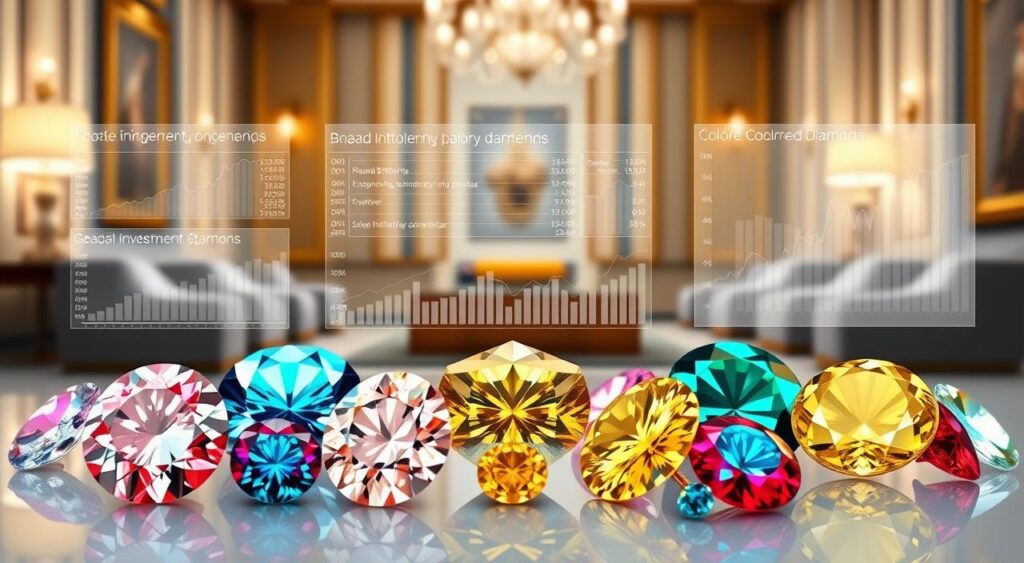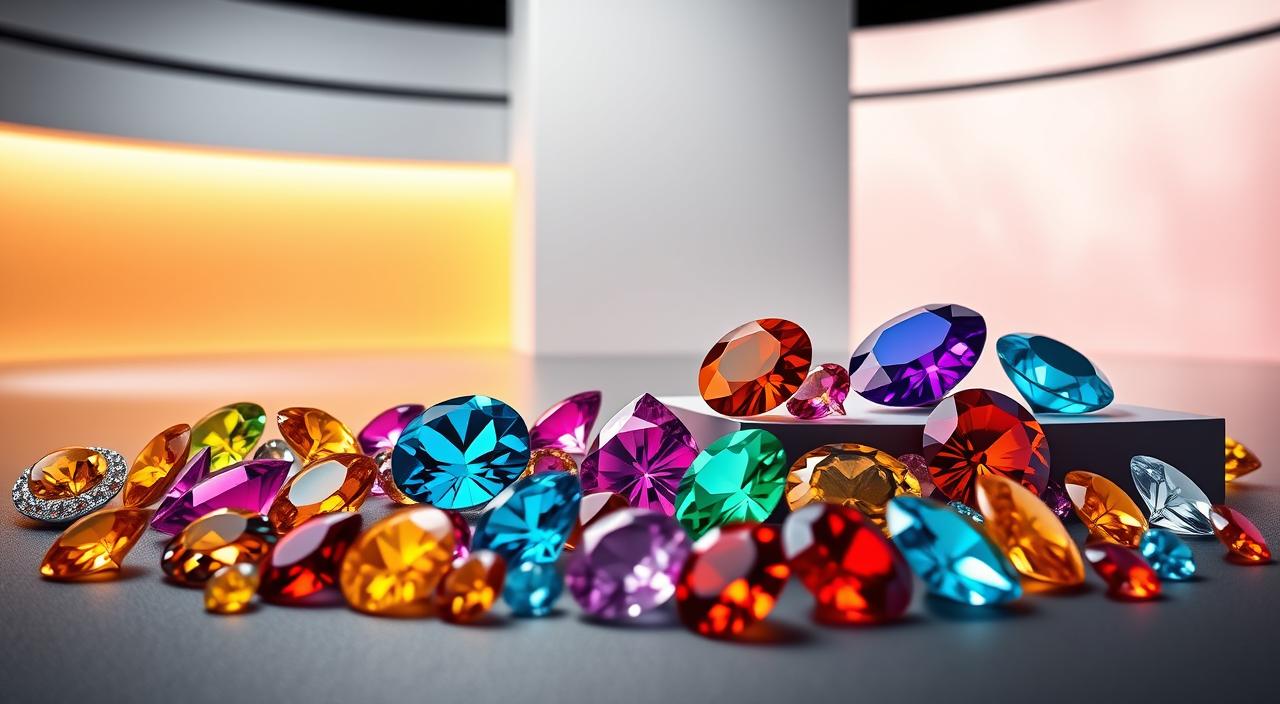In this comprehensive investment guide, we will dive into the world of colored diamonds, exploring their unique appeal and the significant opportunities they present for wealth building and portfolio enhancement. As we venture through this guide, our aim is to equip potential investors with the essential insights needed to navigate the colored diamond market confidently. From understanding their rarity to practical buying strategies, we hope to foster informed decision-making for anyone interested in diversifying their investment portfolios with these exquisite gems.
Key Takeaways
- Colored diamonds offer unique investment opportunities due to their rarity.
- Understanding market trends is crucial for successful portfolio enhancement.
- Setting clear investment goals will guide your approach to colored diamond investment.
- Choosing reputable dealers ensures the authenticity and value of your investment.
- Regular maintenance and assessments are vital for protecting your investment.
- Being aware of the risks associated with market volatility helps in making informed decisions.
Introduction to Colored Diamonds
Colored diamonds, or fancy diamonds, capture our imagination with their stunning hues and unique characteristics. As we explore the fascinating world of these gemstones, we will uncover their definition, the reasons behind their rarity, and the allure that has made them a top choice for gemstone investment. Understanding these aspects enhances not only our appreciation for colored diamonds but also our insight into their market value.
What Are Colored Diamonds?
Colored diamonds encompass a diverse range of colors including blue, pink, yellow, and green. The intensity of their colors can vary significantly, leading to classifications from faint to vivid. The grading of these diamonds depends on crucial factors such as hue, tone, and saturation. This classification system helps buyers make informed decisions in gemstone investment, ensuring they select diamonds that best align with their aesthetic preferences and collection goals.
The Rarity and Appeal of Colored Diamonds
When comparing types of colored diamonds to traditional white diamonds, we recognize that colored variants are incredibly rare. Their formation demands specific geological conditions, which are not commonly found. This rarity contributes greatly to the appeal of colored diamonds in the luxury market. Their striking beauty, combined with their limited availability, makes them highly sought-after treasures for collectors and investors alike.
| Color | Rarity | Investment Appeal |
|---|---|---|
| Blue | Very Rare | High Demand |
| Pink | Extremely Rare | Exceptional Value |
| Yellow | More Common | Good Investment |
| Green | Rare | Growing Interest |
Understanding the Value of Colored Diamonds
In our exploration of colored diamonds, we uncover the various elements that dictate their market worth. Each diamond possesses unique characteristics impacting its colored diamond valuation. Understanding these factors helps us appreciate the intricate balance of beauty and rarity that defines each gemstone. As we delve into market trends, awareness of recent shifts provides insight into investment value appreciation in this sector.
The Factors That Determine Value
Several essential characteristics significantly affect the valuation of colored diamonds. Key factors include:
- Color Quality: Intense and vivid hues generally command higher prices.
- Carat Weight: Larger diamonds typically exhibit greater value due to their relative scarcity.
- Clarity: Stones with minimal inclusions are more prized in the market.
- Origin: The source of the diamond can influence desirability; for example, stones from specific mines can fetch premium prices.
Market Trends in Colored Diamond Valuation
Observing current market trends reveals a growing appetite for colored diamonds as viable investments. Heightened interest arises from a combination of market speculation and an increasing appreciation for distinctive stones. Notably, auctions of these gems often yield record-breaking sales, reflecting a robust engagement in the sector. The dynamics surrounding colored diamond valuation continue to evolve, influenced by shifting consumer preferences and investment strategies.
Why Invest in Colored Diamonds?
Investing in colored diamonds presents unique opportunities for wealth creation and asset preservation. These exceptional gemstones frequently capture attention, not just for their vivid hues and rarity, but also for the tangible investment benefits they offer.
The Benefits of Investing in Colored Diamonds
When considering a gemstone investment, colored diamonds emerge as a prime choice. Their intrinsic value stems from their limited supply and remarkable aesthetic appeal. This investment offers even more than just a beautiful asset; it allows us to secure our financial interests against market fluctuations. Owning colored diamonds provides a sense of satisfaction to collectors, making them both an enjoyable and financially rewarding pursuit.
Long-Term Value and Appreciation Potential
Historical data consistently suggests that certain colored diamonds enjoy robust long-term appreciation. Unlike many conventional investments, the market for these exceptional stones often showcases sustained growth in value. Their track record of maintaining worth speaks volumes about their reliability as a hedge against inflation. As we navigate the world of investment, it’s crucial to recognize that colored diamonds can serve as a substantial component in our portfolios, preserving wealth and offering an attractive outlook for future appreciation.

| Type of Colored Diamond | Average Annual Appreciation (%) | Investment Benefits |
|---|---|---|
| Pink Diamonds | 10 – 15 | High rarity, increasing demand. |
| Blue Diamonds | 8 – 12 | Historical strong performance. |
| Yellow Diamonds | 6 – 10 | Wider market accessibility. |
| Green Diamonds | 5 – 8 | Unique coloring, niche appeal. |
Colored Diamond Investment: How to Get Started
Investing in colored diamonds can be a rewarding venture for those looking to diversify their asset portfolio. To navigate this unique market successfully, we should first lay out our investment goals. Whether we aim for substantial long-term appreciation or more immediate financial returns, our objectives will shape our strategies. This clarity aids in effective decision-making and increases the chances of achieving our desired outcomes.
Setting Your Investment Goals
Defining clear investment goals becomes paramount before embarking on this journey. These goals will serve as a compass, guiding our decisions in this niche market. Our focus might range from appreciating the craftsmanship involved in the creation of colored diamonds to seeking financial gain. Careful consideration of these objectives can delineate our approach to colored diamond selection, leading to more informed choices aligning with our aspirations.
Types of Colored Diamonds to Consider
The investment types available within the realm of colored diamonds vary significantly. Notably, diamonds such as Argyle pinks, blue diamonds, and yellow diamonds each carry different valuations based on rarity and demand. Understanding the nuances in market trends associated with these diamonds maximizes our chances of selecting stones that not only appeal visually but also serve as sound financial investments. Below is a table summarizing key characteristics and market insights for several popular types of colored diamonds:
| Diamond Type | Color Characteristics | Rarity | Investment Potential |
|---|---|---|---|
| Argyle Pink | Ranging from light to deep pink | Very rare, especially in larger sizes | High appreciation potential due to limited supply |
| Blue Diamond | Various shades of blue | Rare, with intense shades being extremely sought after | Strong history of value retention and appreciation |
| Yellow Diamond | Vibrant yellow to deep canary hues | More accessible compared to pinks and blues | Moderate investment potential with a growing market |
| Green Diamond | Natural green hues with varying saturation | Very rare, particularly for natural origin stones | Emerging market with increasing interest and investment |
By understanding the different types available and aligning them with our investment goals, we can build a more robust colored diamond portfolio that resonates with both aesthetic appreciation and financial viability.
Choosing a Reputable Dealer
When embarking on the journey of buying diamonds, selecting a reputable dealer plays a crucial role in ensuring a successful investment. We need to establish trust with the vendors we choose. Trustworthy sellers uphold their integrity and provide genuine products. Here are some essential tips to guide us in finding reliable dealers.
Tips for Finding Trustworthy Sellers
- Conduct thorough research on potential dealers through online reviews.
- Ask for referrals from friends or family who have experience with diamond purchases.
- Attend trade shows to meet dealers and evaluate their offerings firsthand.
- Build a relationship with a trusted dealer to gain ongoing education and support during our investment journey.
Understanding GIA and Other Certifications
Knowledge of diamond certification is essential when buying diamonds. Certifications from reputable organizations, such as the Gemological Institute of America (GIA), authenticate the quality of diamonds. These certifications help us verify a stone’s authenticity and value, fostering confidence in our purchase. Familiarizing ourselves with grading reports and the specifics of certifications allows us to make informed decisions.
Below is a table delineating popular diamond certification organizations and their features:
| Certification Organization | Focus Area | Reputation |
|---|---|---|
| Gemological Institute of America (GIA) | Comprehensive grading including 4Cs | Highly reputable and trusted worldwide |
| American Gem Society (AGS) | Detailed cutting and light performance | Recognized for its strict grading standards |
| International Gemological Institute (IGI) | Various gemstones and jewelry | Well-regarded for its customer-friendly services |
| European Gemological Laboratory (EGL) | Multiple grading factors including origin | Respected, but practices vary by location |
Strategies for Growing Your Colored Diamond Portfolio
Successfully enhancing our colored diamond portfolio involves careful planning and execution. By employing effective investment strategies, we can maximize portfolio growth while navigating the complexities of the market. Understanding how to diversify our investments and assessing market conditions before making purchases are crucial steps in our journey.
Diversifying Your Investment
Expanding our portfolio through a variety of colored diamonds offers numerous benefits. This diversification can include different colors, sizes, qualities, and even sources. By choosing a range of options, we decrease potential risks associated with investing in any single category.
- Investing in multiple colors ensures exposure to varying demand levels.
- Including diamonds of different sizes caters to diverse market tastes.
- Quality variation allows for a broader price range, accommodating various budgets.
Assessing Market Conditions Before Buying
Staying attuned to market trends and economic indicators empowers our buying decisions. Regular market assessment informs us about the right timing for our investments. Key factors to consider include:
- Current demand levels for specific colored diamonds.
- Fluctuations in market pricing that indicate potential growth.
- Economic signals such as consumer spending patterns affecting luxury goods.
The Importance of Proper Care and Maintenance
When we invest in colored diamonds, understanding the significance of proper care and maintenance becomes crucial. These exquisite gemstones require our attention to ensure they remain in excellent condition and continue to appreciate in value. By focusing on diamond care, we not only preserve their beauty but also enhance investment protection through diligent practices.
How to Protect Your Investment
Proper storage and maintenance strategies are vital for colored diamonds. Here are key practices we should adopt:
- Store diamonds in a dry, cool place, preferably in a soft pouch or a separate compartment to avoid scratches.
- Regularly clean our diamonds using mild soap and warm water, possibly with a soft toothbrush for hard-to-reach areas.
- Avoid exposure to harsh chemicals which can damage the gemstone’s surface.
- Consider obtaining insurance specifically tailored for our diamond collection to ensure comprehensive investment protection.
Regular Assessments and Appraisals
Conducting credible appraisals plays a substantial role in safeguarding our investments. We recommend scheduling assessments periodically to track each diamond’s market value. Factors to consider include:
| Assessment Frequency | Purpose | Outcome |
|---|---|---|
| Every 1-2 years | To evaluate current market standing | Ensure proper insurance coverage |
| After major market changes | To determine potential for appreciation | Adjust financial strategies accordingly |
| Before selling | To set a fair, competitive price | Maximize profit from the sale |
Risks Associated with Colored Diamond Investment
Investing in colored diamonds can provide lucrative opportunities, but we must also be aware of the potential investment risks involved. Market volatility is a crucial factor that can affect the overall performance of our investments. It is essential to understand these dynamics to make well-informed decisions.
Market Volatility and Its Impact
The colored diamond market can fluctuate significantly due to various economic conditions. Price swings can lead to uncertainty, making it vital for us to monitor market trends closely. We should consider investing during periods of lower market volatility, as this often presents a more stable environment for purchasing genuine diamonds.
Recognizing Genuine Diamonds vs. Imitations
We must be vigilant against counterfeits and synthetic diamonds, which can closely resemble natural stones. Ensuring we buy from reputable dealers and demanding proper certifications is fundamental in protecting our investments. By being educated about the differences between genuine diamonds and imitations, we can safeguard ourselves from potential financial losses.
Success Stories of Colored Diamond Investors
Exploring the journeys of successful investors in colored diamonds provides valuable perspectives. Their stories embody practical approaches, demonstrating how strategic investment can lead to significant gains. Analyzing these case studies reveals common techniques and insights that can enhance investor success.
Case Studies of Notable Investors
Several experienced investors have had notable success in the colored diamond market. For instance, some have focused on acquiring rare pieces that possess unique colors, such as vivid pinks or deep blues. These investments often see substantial appreciation over time, highlighting the potential for high returns in this niche market.
Lessons Learned from Their Experiences
Investors frequently emphasize the importance of extensive education and research. Building a strong network of reputable dealers contributes to securing the best quality pieces and advantageous pricing. Market awareness plays a crucial role in making informed decisions. Each experience teaches valuable lessons, establishing a roadmap for future investors in the colored diamond space.

Conclusion
As we conclude this comprehensive guide, we can confidently say that we have equipped ourselves with essential colored diamond insights and strategies for successful investment. Understanding the rarity and beauty of colored diamonds, along with their potential to outperform traditional assets, offers us an exciting opportunity for diversified wealth creation. From our exploration of market trends to the importance of reputable dealers, every step of our journey is crucial to optimizing our investments.
In reviewing the investment summary we’ve created, it becomes evident that while these precious gems carry certain risks—such as market volatility and the need to discern authentic stones—we also see their unique advantages as alternative assets. By remaining informed, we can make prudent decisions that help us navigate this vibrant market with confidence.
Ultimately, as we look to finalize our investment in colored diamonds, we recognize the value of preparation and knowledge in achieving success. With a clear understanding of the benefits and challenges, we are poised to embark on a rewarding journey into this captivating sector.
FAQ
What factors should we consider when investing in colored diamonds?
When investing in colored diamonds, we should consider key factors such as color quality, carat weight, clarity, and origin. Vivid color diamonds and larger sizes typically command higher prices in the market.
How do we assess the value of a colored diamond?
The value of a colored diamond is assessed based on its hue, tone, and saturation. The grading reports provided by reputable organizations like the GIA can help us understand these factors better.
Why are colored diamonds considered a good investment?
Colored diamonds are considered a good investment due to their rarity, long-term appreciation potential, and ability to act as a hedge against economic downturns. Collectors and investors alike find their unique features appealing.
What should we look for when choosing a dealer for our colored diamond investment?
To choose a reputable dealer, we should check online reviews, ask for referrals, and potentially visit trade shows. Building a relationship with a trustworthy dealer will enhance our investment experience.
How frequently should we have our colored diamonds appraised?
We should consider conducting appraisals regularly to ensure our investment is accurately valued and protected. Periodic assessments facilitate tracking any appreciation in value and necessary adjustments to our insurance.
What are the risks associated with colored diamond investments?
The main risks include market volatility and the potential for counterfeiting. It’s crucial for us to stay informed about market conditions and to demand proper certifications to distinguish genuine diamonds from imitations.
How can we protect our colored diamond investment?
To protect our investment, we should store our diamonds properly, clean them regularly, avoid harsh chemicals, and consider obtaining quality insurance coverage to safeguard against potential loss or damage.
Which types of colored diamonds should we consider for investment?
We should consider investing in various types of colored diamonds, such as Argyle pinks, blue diamonds, and others that align with current market trends and rarity characteristics.
What are market trends currently influencing colored diamond valuations?
Current market trends show increasing demand for colored diamonds driven by speculation and growing appreciation for unique stones, evidenced by record-breaking auction sales, which indicates a strong investment potential.
What lessons can we learn from successful colored diamond investors?
Successful investors emphasize the importance of education, market research, and establishing relationships with reputable dealers to navigate the colored diamond market effectively and achieve investment success.
